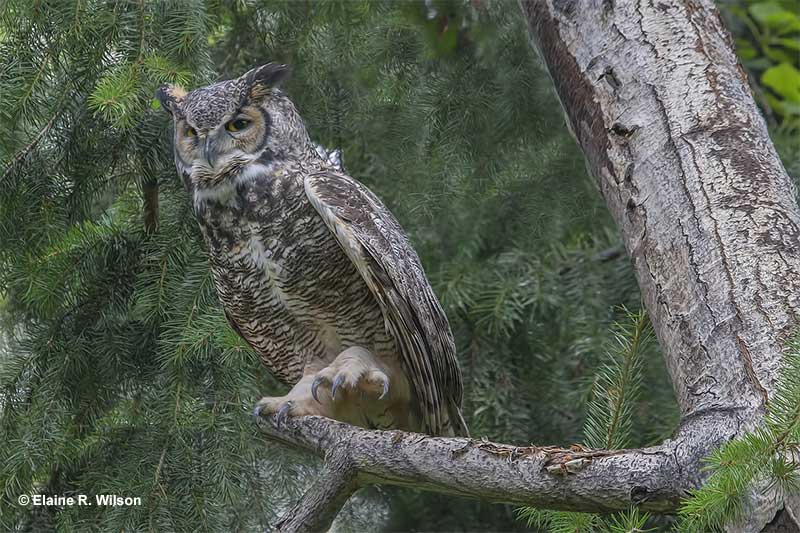
Missouri is a great place to see owls! The loud “Who Cooks for You!” call of the Barred Owl echoes from woodlands throughout the state. Huge Great Horned Owls breed in every habitat, and pint-sized Eastern Screech-Owls hide in local parks.
Go birding in Missouri, and you’ll find owls. Which owl species in Missouri can you expect to see? Which owls are rare?
See answers about the owls of Missouri in this article!
On this page
How Did We Gather The Data?
As with everything in this world, data is the key. Using eBird bird spottings, we assembled this list of nine owls, most commonly spotted in Missouri.
Barred Owl
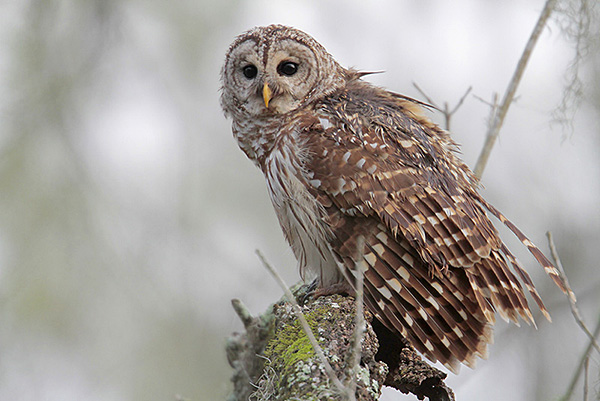
Photograph © Greg Lavaty.
- Range: A permanent resident in most forested areas in Canada, parts of some Pacific Northwestern states, and most of the eastern USA.
- Length: 21 inches
- Wingspan: 42 inches
- Call: Makes loud hooting and caterwalling sounds, “Who cooks for you?! Who cooks for youaaaal!”
The Barred Owl is a medium to large owl with a round head and a narrow black border on its pale gray face. It has dark brown upperparts with white markings, and dark brown streaks on its belly.
This species also has a yellowish beak and dark eyes. Both sexes look the same except that females are a bit larger than males.
Barred Owls live in deciduous and coniferous forests and woodlands. It nests in the abandoned nests of raptors and crows and in tree cavities.
Key Identifications:
- Big owl with a round head that has white marks on dark brown upperparts, and dark brown streaks on pale underparts.
- Perches and swoops through wooded areas at night but can also be active in the day.
- Nests in tree cavities and in abandoned nests of crows and hawks.
- Catches a wide variety of small animals.
Great Horned Owl
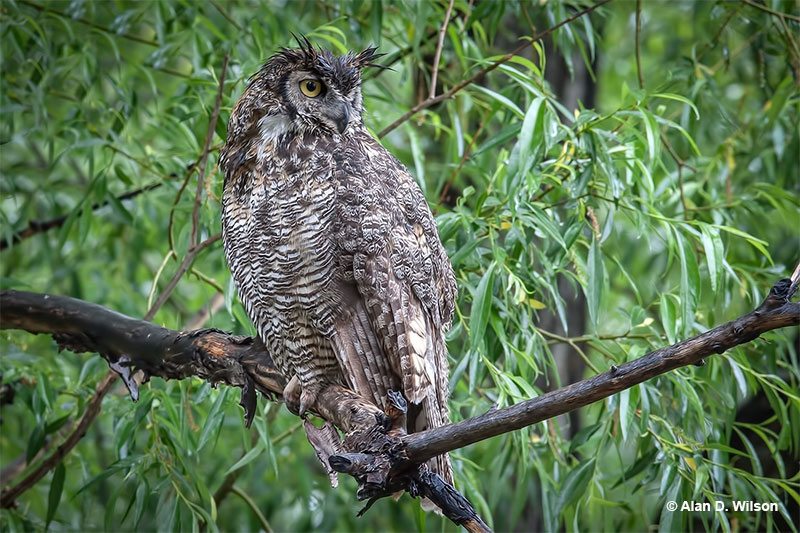
- Range: Permanent resident in much of Alaska, Canada, and the USA.
- Length: 22 inches
- Wingspan: 44 inches
- Call: Makes a low, gruff, “hooo, hoo hoo hoo hoooo”.
The Great Horned Owl is a big, bulky owl with big ear tufts and a black beak. It is mottled gray and brown, has a rufous or gray face, and fine black barring on its underparts. This owl also has a white throat and some dark marks on its breast.
Males and female Great Horned Owls look the same but females are larger. They also have a medium-length tail with dark bands, and long, broad wings.
This nocturnal owl species lives in every possible habitat, including urban areas.
Key Identifications:
- Big, bulky brown or gray owl with ear tufts and fine barring on its underparts.
- Nests in old stick nests of other large birds, on ledges, and in other situations.
- Watches from a perch or glides over open habitats at night, to catch mammals and some birds on the ground.
Eastern Screech-Owl
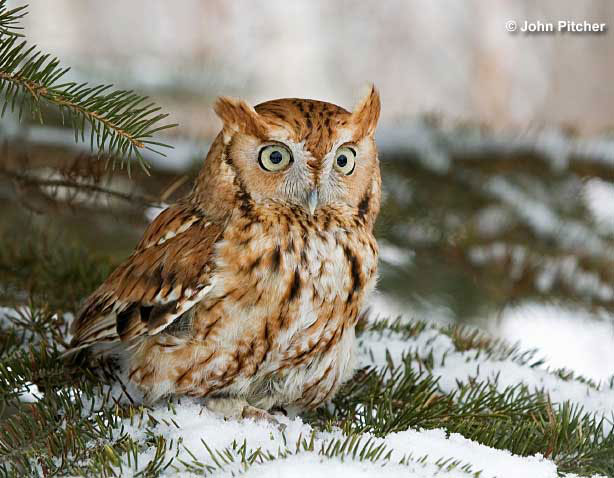
- Range: Permanent resident in parts of southeastern Canada, and in much of the eastern USA.
- Length: 8.5 inches
- Wingspan: 20 inches
- Call: Makes a rather high-pitched, descending whinny call, and a tremulous, vibrating call on the same pitch, “wududududududududududu”.
The Eastern Screech Owl is a small owl with ear tufts. It can be reddish, brown, or mostly gray, has “V”-shaped pale eyebrows, and some black on the edge of its face. It is also mottled above with some white spotting, and has pale underparts with dark barring and streaks.
Males and females look alike but females are a bit larger. This species also has yellow eyes, a pale yellow-gray beak, and some white bands on its broad tail.
During the day, this owl hides in holes, or in dense vegetation. Eastern Screech Owls are common owls in Missouri, with most birds staying year-round.
Key Identifications:
- Small owl with ear tufts and mottled brown or gray plumage that lives east of the Rocky Mountains.
- Lives in a variety of wooded and park-like habitats.
- Nests in tree cavities and nest boxes.
- Swoops down to the ground catch a variety of small animals at night.
Short-eared Owl
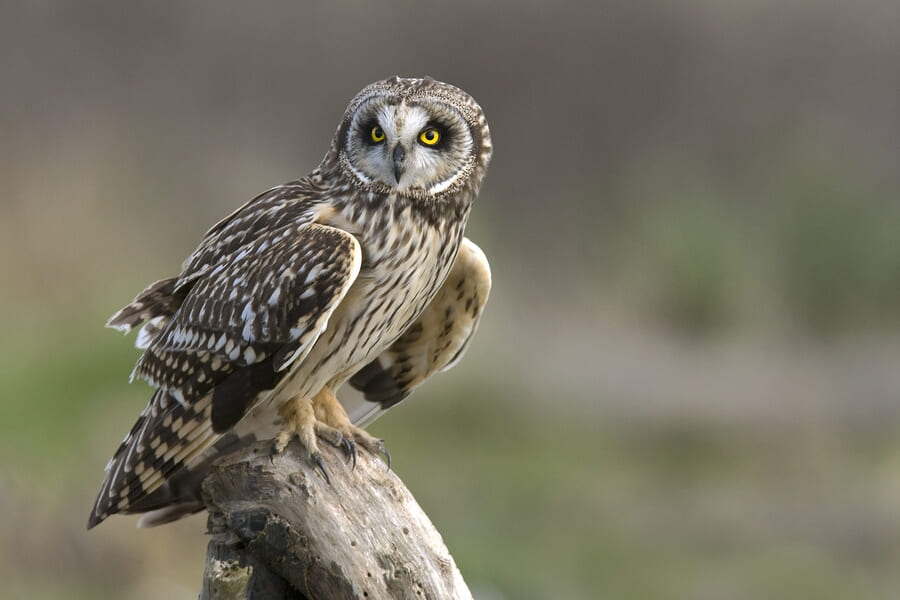
- Range: Summer resident in Alaska, Canada, and the western and central USA. Northern birds migrate to the USA, south to California and Texas.
- Length: 15 inches
- Wingspan: 38 inches
- Call: Makes a hoarse, raspy, cat-like call, “rehw”.
The Short-eared Owl is a medium-sized, pale brown owl with dark eye patches on a pale face. They have a dark breast and streaks on pale underparts. This species has long wings with buff wing patches.
Both sexes look similar but females are a bit larger and usually darker and buffier.
This owl is active day and night in open fields. They are common wintering owls in Missouri.
Key Identifications:
- Medium-sized pale brown and buffy owl with very short ear tufts.
- Dark eye patches on a pale face and long wings with buff patches near the wingtips.
- Nests on the ground in dense vegetation.
- Glides over open fields to catch small animals on the ground.
Barn Owl (rare)
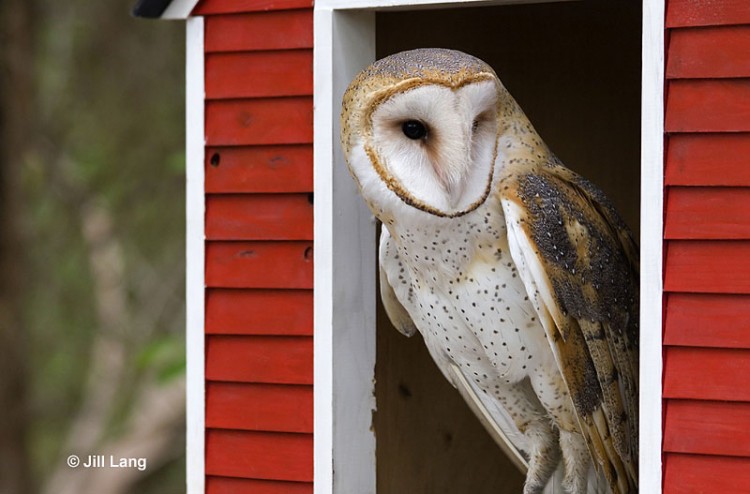
- Range: In Canada, occurs mostly in southwestern British Columbia. In the USA, they live in many areas but are absent from mountains and cold, northern regions. They range north to Washington, Nebraska, Iowa, and New York.
- Length: 16 inches
- Wingspan: 42 inches
- Call: A shrill, loud, hissing “shriiiiii!”
The Barn Owl is a medium to large, pale owl with golden tan and gray upperparts, and white underparts. It has a distinctive, white, heart-shaped face.
Both sexes are alike, but females are a bit larger than males and have buff on their chests.
In flight, Barn Owls look like a large, pale, moth-like bird with a big, rounded head.
Barn Owls usually live in somewhat urban and open habitats in regions with mild or no winters. In Missouri, they have small year-round populations, but it’s generally pretty hard to spot them.
Key Identifications:
- Large pale owl with a heart-shaped face.
- Glides and flutters over fields and other open areas at night.
- Nests in tree cavities, crevices in church steeples and other structures, and next boxes.
- Preys on rats and other small animals.
Snowy Owl (vagrant)
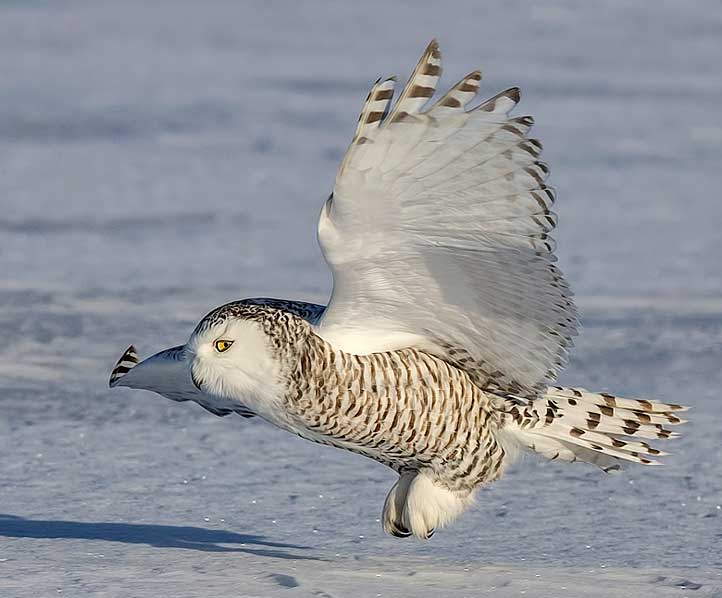
- Range: Summer resident in northern Alaska and northern Canada. It winters in Canada and the northern USA.
- Length: 23 inches
- Wingspan: 52 inches
- Call: Usually quiet but occasionally makes a low, gruff call, “whew…whuh”.
The Snowy Owl is a big, mostly white owl with a round head and yellow eyes. Some males are mostly white, but most have some small dark marks. Females and young birds have white faces and varying degrees of black barring.
Females are a bit larger than males and have more black markings than males. Snowy Owls also have long, broad wings and a broad tail.
Snowy Owls sometimes make their way to more southern areas; in the United States, they are more common in Wisconsin and some northern areas of Washington, Montana, North Dakota, and Minnesota, along with some other northeastern states.
Key Identifications:
- Big white owl with a round head, and varying degrees of black or dark gray barring and spots.
- Lives in tundra and winters in wide open habitats.
- Nests on the ground, on elevated spots in Arctic tundra.
- Watches from a perch and glides low to catch small animals on the ground.
Northern Saw-whet Owl (rare)
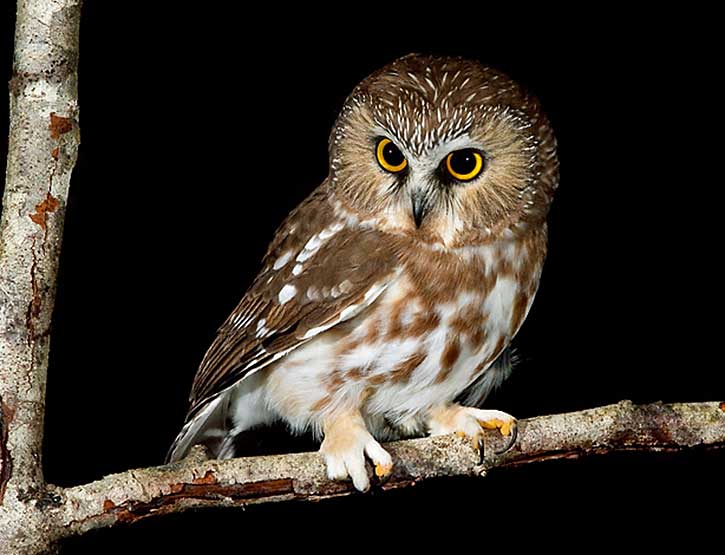
- Range: Lives in coniferous and mixed hardwood forests of Alaska, a large area of Canada, and parts of the northern and western USA.
- Length: 8 inches
- Wingspan: 17 inches
- Call: Makes a repeated tooting whistle call, over and over, “tu, tu, tu, tu, tu, tu, tu, tu, tu”.
The Northern Saw-whet Owl is a small, dark brown owl with a round head and brown streaks on white underparts. It also has some pale streaks on its head, a brown and white face, and some white spotting on its back.
Both sexes look the same but females are a bit larger. This species also has yellow eyes, a dark beak, longish, rounded wings, and a short, broad tail.
Northern Saw-whet-Owls occasionally stop in Missouri during migration. They mainly breed in Canada and in some northern and western states in the U.S., with some migrating to warmer climates for winter.
Key Identifications:
- Small, dark brown owl with a round head, broad white eyebrows, and thick dark streaks on pale underparts.
- Occurs in dense coniferous and mixed forest.
- Nests in old woodpecker holes and can use nest boxes.
- Swoops down to catch insects and small animals at night.
Burrowing Owl (vagrant)
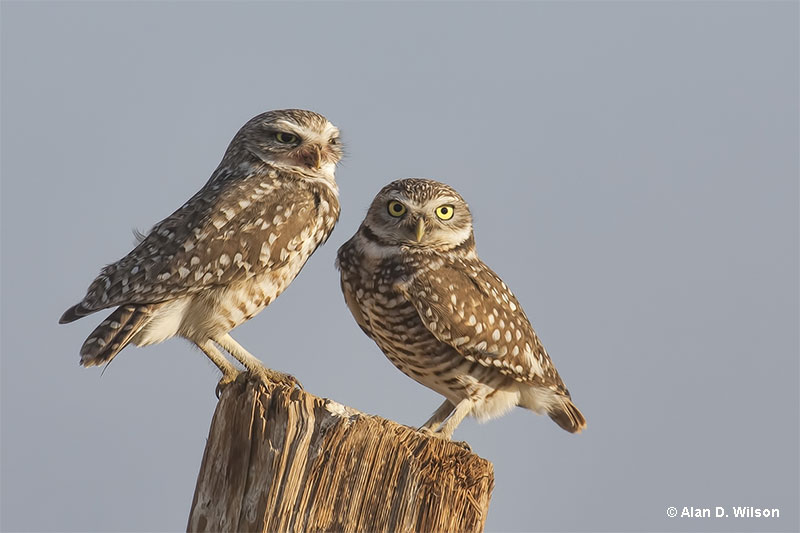
© Alan D. Wilson
- Range: Summer resident in central-southern Canada, the Great Plains, and much of the western USA. Permanent resident in California, Texas, and Florida.
- Length: 9.5 inches
- Wingspan: 21 inches
- Call: Makes a raspy, chattering call, “rap, rip,rip,rip,rip”, and a quail-like, “whup waaah!”.
The Burrowing Owl is a small, long-legged owl with a white throat and white eyebrows. It has a round head, is dark brown with white spots above, and has pale underparts with dark barring.
Males and females look alike although females are a bit larger. Young birds are uniform dark brown and buff.
Burrowing Owl is active day and night in grasslands, deserts, and other open habitats. In Missouri, these owls are rare vagrants, probably blown off course. Burrowing Owls are much more common in southern states, and in the western side of North America.
Key Identifications:
- Small, long-legged owl with a round head, and some brown barring on pale underparts.
- Lives in grasslands and other wide-open habitats.
- Nests in burrows made by prairie dogs and other animals although birds in Florida make their own burrows.
- Catch small animals on the ground at any time of the day or night.
Long-eared Owl (rare)
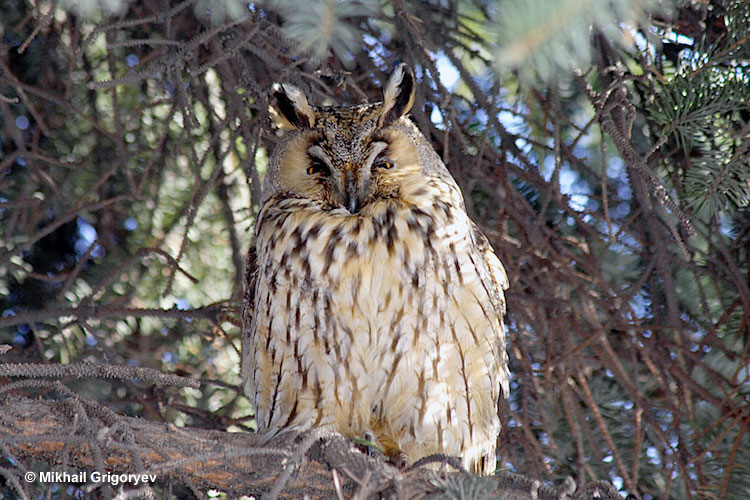
- Range: Migrant in southern Canada, resident and winters in much of the USA. Absent from parts of the Pacific Northwest and southeastern states.
- Length: 15 inches
- Wingspan: 36 inches
- Call: Makes a single, one second long “Hooo!” call at regular intervals.
The Long-eared Owl is a medium-sized, slender owl with long ear tufts. It has an orange face, is mottled gray above, and has dark brown streaks and marks on pale underparts. This owl also has long wings with a rufous patch in its primaries.
Male and female Long-eared Owls look similar, but females are larger. This owl species also has yellow eyes, and some pale markings between its eyes and around its dark beak.
Long-eared Owls might choose a cozy area in Missouri for wintering, but they are rarely spotted.
Key Identifications:
- Medium-sized, slender owl species with long ear tufts, orange on its face, and long wings with an orange-brown patch near the wingtips.
- Occurs in coniferous and mixed forests near meadows, bogs, and other open areas.
- Nests in old crow, magpie, and hawk nests.
- Glides over open habitats near forest at night to catch small animals on the ground.
Frequently Asked Questions
What is the most common owl in Missouri?
The most common owl in Missouri is the Barred Owl. This species lives in wooded areas throughout the state.
What are the gray owls in Missouri?
Gray owls in Missouri could be Barred Owls or Eastern Screech-Owls. Barred Owls are big and lack “ear tufts” while Eastern Screech-Owls are small and have feathered “ear tufts”.
What does the owl sound like in Missouri?
In Missouri, owls can sound like a few different species. Barred Owls make loud calls that sounds like, “Who cooks for you!“. Great Horned Owls make deep hooting calls, and Eastern Screech-Owls make trilling and horse-like whinny sounds.
Do screech owls live in Missouri?
Yes, screech owls live in Missouri. The Eastern Screech-Owl is a common species in the state.
Read next: Birds in Missouri | Hawks in Missouri | Woodpeckers in Missouri

